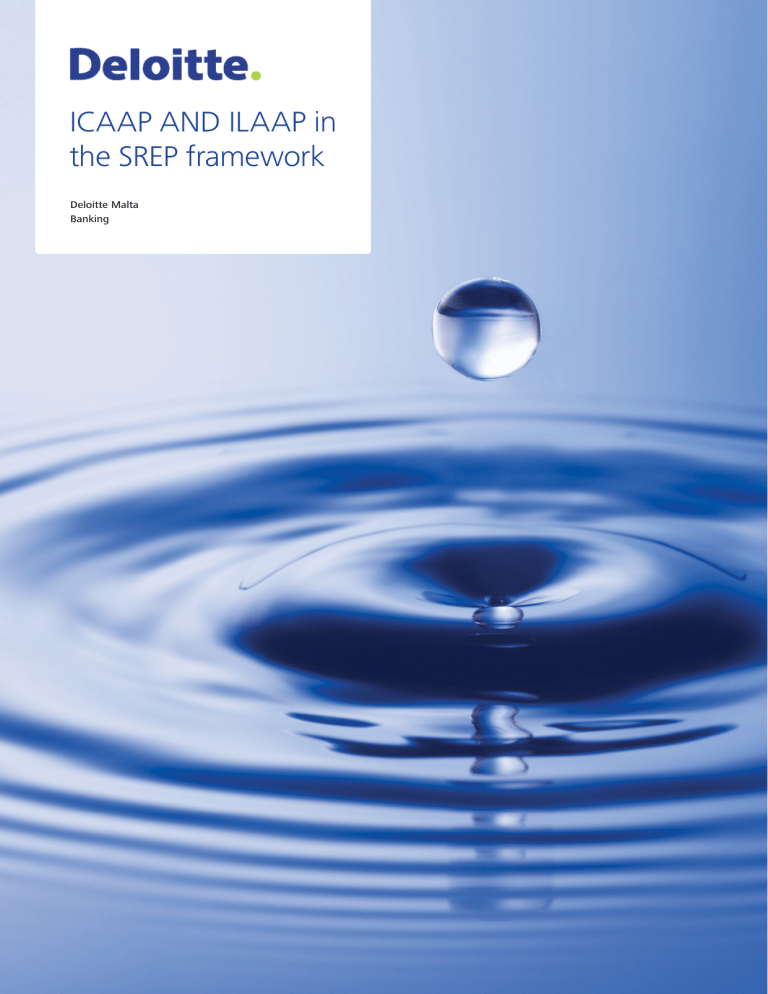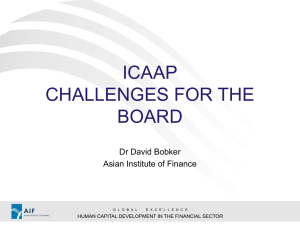
ICAAP AND ILAAP in the SREP framework Deloitte Malta Banking Second line optional lorem ipsum B Subhead lorem ipsum, date quatueriure Engaging title in Green Descriptive element in Blue 2 lines if needed Introduction to SREP guidelines Key elements On July 7 2014, the EBA published a consultation paper on guidelines for common procedures and methodologies for the Supervisory Review and Evaluation Process (SREP) under Article 107 (3) of Directive 2013/36/EU (CRD IV). The guidelines are addressed to NCAs and cover all aspects of SREP. Final guidelines The consultation closed on 20 October 2014 and responses were subsequently published on the EBA website. The final guidelines which were published in December 2014, and have been applicable since 1 January 2016, include guidance on: a. Categorisation of institutions b. Monitoring of key indicators c. Business model analysis d. Assessment of internal governance and institutionwide controls e. Assessment of risks to capital –– Assessment of inherent risks and controls –– Determination of own funds requirements and stress testing –– Capital adequacy assessment f. Assessment of risks to liquidity and funding –– Assessment of inherent risks and controls –– Determination of liquidity requirements and stress testing –– Liquidity adequacy assessment g. Overall SREP assessment h. Supervisory measures –– Quantitative capital measures –– Quantitative liquidity measures –– Other supervisory measures i. Early intervention measures Overarching observations A comprehensive, structured framework • The guidelines have a broad sweep and significantly expand the scope of a traditional SREP exercise by proposing a structured approach to the SREP. • Supervisors are expected to assess and score individual elements of the SREP on a scale of 1 to 4. The score is based on risk assessment and the firm’s ability to manage and mitigate such risks. • An overall score is provided to each firm (1-4 and ‘F’ representing likelihood of failure). • Supervisors are also expected to conduct a comprehensive analysis of the business model and internal control framework. Articulation of firm-specific capital requirements • The guidelines introduce a ‘Pillar 1 Plus’ approach for the NCAs. • They introduce the concepts of Total SREP Capital Requirements (TSCR) and Overall Capital Requirement (OCR) which will be fundamental to the assessment of capital adequacy. • The guidelines set expectations relating to composition of capital for Pillar 2 risks. • EBA expects firms to operate above both P1 and P2 capital requirements under stressed conditions. This effectively crystallises the nature of P2 requirements as being binding constraints rather than being ‘guidance’. Integration • Firms are expected to articulate the linkages between their ICAAP, liquidity assessments and recovery and resolution plans. In addition, firms should evidence linkages between their overarching business model, business strategy and plans and top-down and bottom-up assessments of risk. • The scope of the SREP has been expanded to cover the assessment of institutions’ viability. • Through the overall SREP score, supervisors can determine firms’ viability and consequent likelihood of failure which can inform the requirements arising from EBA’s Recovery and Resolution Directive (2014/59/EU). Deloitte Malta ICAAP AND ILAAP in the SREP framework 1 SREP framework Review of ICAAP and ILAAP in the SREP context Representation of the SREP, which will be applied in 2016 1. Assessment of inherent risks and controls 2. Determination of own funds requirements and stress testing 3. Capital adequacy assessment C E F Assessment of risks to liquidity and funding Monitoring of key indicators Assessment of risks to capital B D Assessment of internal governance and institution-wide controls A The SREP framework Categorisation of institutions Business model analysis I Early intervention measures H Supervisory measures G Overall SREP assessment 1. Quantitative capital measures 2. Quantitative liquidity measures 3. Other supervisory measures 1. Assessment of inherent risks and controls 2. Determination of liquidity requirements and stress testing 3. Liquidity adequacy assessment 2 A B C Categorisation of institutions Monitoring of key indicators Financial Institutions will be distributed in four categories (Level 1 to 4), according to the systemic risk they represent. The level of frequency and intensity of the monitoring, changes depending on the category (Level 1 being the most intense). The quarterly monitoring of the main financial and non-financial indicators of all the Financial Institutions, intermediated with the SREP’s evaluations, will allow to identify any potential deterioration on the risk profile and lead to an update on the evaluations of all SREP components. Business model analysis This analysis consists of: 1. The evaluation of the viability of the business model on a year time horizon; 2. The evaluation of the sustainability of the strategy in the next three years; 3. The identification of the main vulnerabilities that may impact the bank or lead to a situation of recovery/resolution. D Assessment of internal E This evaluation’s main focus is: There will be evaluations to the material risks identified for the bank, which will result in a grade that is based on the inherent risk and on the management and control of existing risks. governance and institution-wide controls 1. To guarantee that the governance model and the implemented controls are adequate to the risk profile, business model, size and complexity of the bank; 2. To evaluate the degree of compliance of the bank with the requirements and standards of a good governance and internal control practices. Assessment of risks to capital This evaluation will use the bank’s ICAAP as its main tool. The output will then be used to determine the adequate capital levels. F Assessment of risks to liquidity and funding This evaluation is focused on the liquidity and funding risks, as well as on its management and on the existing internal controls. It will use as its main tool the bank’s ILAAP and it can result in specific measures to comply with the liquidity requirements previously defined. Deloitte Malta ICAAP AND ILAAP in the SREP framework 3 Introduction to Pillar 2 Components SREP Conceptual understanding of SREP and ICAAPs Pillar 2 is not merely a simple capital adequacy assessment. It combines institutions’ Internal Capital Adequacy Assessment Process (ICAAP) and supervisors’ SREP. The ICAAP (performed by the bank) is an internal risk based assessment of capital requirements and resources, whist the SREP (performed by the regulator) is a review and challenge of the ICAAP and underlying processes. Under the EBA guidelines, the scope of the SREP has considerably widened to include many other elements: including business model analysis, Individual Liquidity Adequacy Assessment Processes (ILAAPs), internal governance and controls. SREP Business model analysis The supervisor will: • Have a clear understanding of its strategic vision and business model. • Identify, review and evaluate the firm’s business model, viability and sustainability and risks and controls; • Have appropriate documentation that supports the articulation of the business model. • Assess, review and evaluate the ICAAP and other documents and compliance with regulatory minimum standards; • Assess linkages with ILAA and RRP; • Ensure that the board and senior management have a consistent view of the Bank’s business model. • Ensure that key dependencies and vulnerabilities relating to the business model are identified. Internal Capital Adequacy Assessment Process (ICAAP) • Set Individual Capital Guidance (ICG) & other Pillar 2 measures; • Have a robust enterprise-wide risk management framework. • Impose systems and controls improvement requirements; • Identify and assess all material risks. • Restrict business, if necessary. • Assess its business model and its on-going viability and sustainability. • Identify and implement controls to mitigate identified risks. • Identify the amount and quality of internal capital in relation to its risk profile, business strategy and plan. • Demonstrate capital adequacy. Individual Liquidity Adequacy Assessment Process (ILAAP) • Have a clear understanding of its liquidity characteristics. • Assess its liquidity risks from an asset and funding illiquidity perspective. • Assess the appropriateness of governance and controls to identify, assess and manage liquidity risks. • Identify the amount and quality of liquidity resources to be kept in relation to its risk profile, business strategy and plan. • Demonstrate liquidity adequacy. Internal governance and controls • Establishment of appropriate internal governance, controls and frameworks. • Alignment to over-arching risk appetite, strategy, business model and plans. Board and senior management should consider that ICAAPs and other related documents are not merely compliance exercises – they represent a holistic assessment of the bank’s risks and capital and liquidity requirements on a current and projected basis under normal and stressed conditions and should be integrated with the bank’s strategy, risk appetite and operational management. 4 SREP framework Where do ICAAP and ILAAP come in? What is SREP? 1 Business model analysis 2 Assessment of internal governance and controls SREP Elements Overall internal governance framework Internal control framework Remuneration policies and practices Corporate and risk culture Risk management framework, including ICAAP and ILAAP Organisation and functioning of the management body Information systems and business continuity • SREP constitutes for regulators a common framework and methodology for assessing the institutions’ risks and viability. • The four elements of the SREP framework are assessed and scored on a scale of 1 to 4. Where does ICAAP & ILAAP come in? • As part of SREP, competent authorities will assess the ICAAP and ILAAP on the basis of: Recovery plan arrangements 1. Soundness: are policies and processes appropriate for maintaining an adequate level of capital and liquidity to cover risks to which the institution is exposed? 3 Assessment of risks to capital 2. Effectiveness: to what extent is ICAAP and ILAAP embedded in decision-making? 4 Assessment of risks to liquidity and funding 3. Comprehensiveness: are all business lines, legal entities and risks covered? 07.07.14 19.12.14 11.12.15 Consultation on draft guidelines on SREP Final guidelines on SREP methodologies and process Consultation on draft guidelines on ICAAP and ILAAP information Deloitte Malta ICAAP AND ILAAP in the SREP framework 5 SREP framework SSM expectations on ICAAP and ILAAP Integration with the business strategy Assumptions and key parameters Institutions are expected to have their ICAAP and ILAAP processes intertwined with the business strategy of the Bank. Banks’ risk appetite and stressed scenarios reflect the business model, and the parameters and results emanating from the ICAAP and ICAAP processes should be used for business decision making. ICAAP and ILAAP will therefore be used as management tools not simply regulatory documents. These should be set in line with risk appetite, market expectations, business model and risk profile. Inter-risk diversification effects Institutions should be transparent and produce gross figures in addition to net figures. Governance Severity level of stress tests and stress testing scenario definition Institutions should produce at least once per year, a clear formal statement on their capital adequacy supported by an analysis of ICAAP outcomes, approved and signed off by the management body. Scenarios have to be tailored to the institution’s vulnerabilities resulting from its business model and operating environment. At least once a year, institutions shall perform an in-depth review of their vulnerabilities. General design The shorter term perspective must be complemented by a longer term (usually at least a three-year horizon) forward looking process. ICAAP perspective Institutions are expected to implement a proportionate ICAAP approach aimed at the survival of the institution. Risks considered Credit Pillar I Institutions are responsible for implementing a regular process for identifying all material risks, as shown opposite. Market Operational Definition of internal capital This has to be consistent with the ICAAP perspective on capital needs. The SSM pays particular attention to the quality of capital. Interest rate Pension Participation Funding cost Concentration Pillar II 6 Soeverign Business/ strategic How can Deloitte assist? The Deloitte phased approach to ICAAP Through our granular understanding of regulatory expectations we are able to assist you in the development of your ICAAP process 1 Business and financial planning 2 Risk and capital assessment 3 Preparation of ICAAP report Phase Description Key Deliverables Phase 1 • Discussion on business strategy and determination of key underlying assumptions; • Financial statements (balance sheet and profit and loss); • Discussion of assumptions, gaps and improvements; • Collection and analysis of information about current methodologies; • Capital plans. • Review of the models and development of new models (where applicable) that consider both quantification of risks and aggregation of risks; • Assist in business plan and financial forecasts. Phase 2 • Risk assessment – current and forward looking basis; • Risk based capital assessment; • Review of the calculations and simulations for the quantification and aggregation of risks, including risk-type level stresses and stressed capital requirements (macroeconomic stresses); • Determination of capital requirements and resources; • Stress test results assessment; • Capital adequacy assessment. • Documentation of the results; • Capital adequacy assessment. Phase 3 • Develop key findings and conclusions; • Final ICAAP report; • ICAAP documentation, including improvements on the models and the report; • Regulatory discussions. • Discussion and review of the ICAAP through the governance process; • Consideration of enhancements; • Final report and approval. 8 ICAAP development and integration to SREP ICAAP process overview Through our granular understanding of regulatory expectations we are able to assist you in the development of your ICAAP process. Phase 1: Business and financial planning Business strategy Determination of key underlying assumptions Business planning Financial forecasts Capital plan Phase 2: Risk and capital assessment Risk assessment current and forward looking basis Risk based capital assessment Risk type level stresses Stressed capital requirements (macroeconomic stresses) Capital adequacy assessments 1 2 Identify material risks, exposures and drivers 4 3 Develop methodology 5 Apply shocks Phase 3: Documentation and governance 1 Develop macroeconomic forecasts Determine calibration levels 6 2 4 3 Identify key input variables 5 Translate impact on key variables 6 Compare with P1 Determine add-on Management and mitigation actions Consider Basel III requirements Compute final capital requirements Develop key findings and conclusions ICAAP documentation Discussion and review of the ICAAP through the governance process Consideration of enhancements Final documentation and approval Deloitte Malta ICAAP AND ILAAP in the SREP framework 9 The Deloitte phased approach to ILAAP We can assist you to face the challenges the integration of the ILAAP process introduced in 2016. 1 Conduct review of existing process 2 Review quantitative framework 3 Preparation of ILAAP report Phase Description Key Deliverables Phase 1 • Conduct a detailed review of the bank’s liquidity risk management framework to identify any inconsistencies/gaps with Basel Principles, regulatory guidelines (including SREP) and a benchmark peer bank European ILAAP; • Expanded Deloitte high level review report • Highlight specific areas within each of the bank’s liquidity policy documents which need to be enhanced to address any gaps identified including suggested language and quantitative metrics; • Discuss high level ILAAP structure and flow. Phase 2 • Review key liquidity risk drivers and liquidity stress testing scenarios, identifying any required enhancements; • Assist in expansion of quantitative analysis including proposing new liquidity risk metrics (if required); • Assist in assessment of adequacy of risk appetite and contingency funding plan; • Summary document covering recommendations for enhancement of the quantitative liquidity framework and stress scenarios including a roadmap to determine liquidity buffer • Assist in assessment of supporting rationale for key liquidity metric thresholds and limits; • Assist in assessment of the level, quality and process for determination of the liquidity buffer. Phase 3 • Finalise ILAAP document format; • Draft ILAAP document (including identifying any supporting documentation) and ensure it meets requirements as identified; • Independent challenge of final draft and production of ILAAP document for management sign off. 10 • Final ILAAP Report ILAAP development and integration to SREP ILAAP process overview • Comprehensive understanding of the business model and its weaknesses • Short and protracted • Idiosyncratic and market wide • Combined scenario • Assessment of inherent liquidity risk • Assessment of funding plan and its stability Business model assessment Stress testing • Range of severe but plausible stress scenarios linked to the inherent business model • Evaluation of market access • Early warning indicators • Tested and actionable contingency funding plan CFP and counterbalancing ILAAP Process Identify, measure, manage and monitor Risk appetite • Consistent with the business model • Approved by the board • Align to resolution and recovery plan Funding and liquidity management • Governance structure • Controls and limits • Cash flows • Intraday liquidity risk management • Collateral management Liquidity buffer • Hold eligible high quality liquid assets • Ability to monetise in a stressed market • Market access • Price risk • Funds transfer pricing • Fragmentation of liquidity Deloitte Malta ICAAP AND ILAAP in the SREP framework 11 ILAAP development and integration to SREP We can assist in developing and integrating your ILAAP process along with leading market practice. • Within the SREP related to the implementation of CRR/ CRD IV (‘Basel III’), the ILAAP is introduced as a new assessment process complementary but distinct to the ICAAP, with the view of strengthening the robust management of liquidity risk • ECB considers ICAAP and ILAAP as management tools not regulatory reports, and will evaluate the business plan and operation of the bank based on how well they are integrated in SREP • Integration does not relate only to risk management but also to commercial strategy. How are for example ICAAP and ILAAP interacting with RWA calculation methodology, credit risk and product pricing? • The ILAAP will be reviewed and scored by competent authorities in the context of the SREP’s risk assessment, in parallel with the review and assessment of the ICAAP and other institution’s organisational aspects • Weak scores in the SREP whether linked to ILAAP, ICAAP or other aspects of an institution are expected to lead to additional capital and liquidity requirements, requests for qualitative adjustment of the business model or other sanctions 12 Key benefits from ILAAP • ILAAP greatly increases consistency between the strategy of the bank and operational processes. A liquidity risk appetite is defined on a strategic level and translated into qualitative statements and risk metrics at an operational level; • ILAAP meets the expectations of the regulator on banks’ liquidity risk management; • ILAAP gives an overview of the liquidity risk on a bank-wide consolidated level. (Possibility to analyse the impact of stress scenarios on its consolidated, group-wide, and individual entities); • ILAAP produces a clear publication improving transparency of the banks’ liquidity risks to regulators; • ILAAP provides a systematic approach to assess liquidity risks and to decide on additional risk controls required. The bank can execute an internal assessment of how liquidity risk is managed and check if the required minimum level of liquidity risk is maintained; • ILAAP evaluates the suitability of the current liquidity profile of the bank and the level of actual liquidity expressed in absolute amount, ratios and limit breaches, etc. For further information contact: Matthew Xuereb Manager - Banking mxuereb@deloitte.com.mt Deloitte refers to one or more of Deloitte Touche Tohmatsu Limited, a UK private company limited by guarantee (“DTTL”), its network of member firms, and their related entities. DTTL and each of its member firms are legally separate and independent entities. DTTL (also referred to as “Deloitte Global”) does not provide services to clients. Please see www.deloitte.com/mt/about for a more detailed description of DTTL and its member firms. Deloitte Malta refers to a civil partnership, constituted between limited liability companies, and its affiliated operating entities: Deloitte Services Limited, Deloitte Technology Solutions Limited, Deloitte Consulting Limited, and Deloitte Audit Limited. The latter is authorised to provide audit services in Malta in terms of the Accountancy Profession Act. A list of the corporate partners, as well as the principals authorised to sign reports on behalf of the firm, is available at www.deloitte.com/mt/about. Deloitte provides audit, consulting, financial advisory, risk management, tax, and related services to public and private clients spanning multiple industries. With a globally connected network of member firms in more than 150 countries and territories, Deloitte brings worldclass capabilities and high-quality service to clients, delivering the insights they need to address their most complex business challenges. Deloitte’s more than 225,000 professionals are committed to making an impact that matters. This communication contains general information only, and none of Deloitte Touche Tohmatsu Limited, its member firms, or their related entities (collectively, the “Deloitte Network”) is, by means of this communication, rendering professional advice or services. Before making any decision or taking any action that may affect your finances or your business, you should consult a qualified professional adviser. No entity in the Deloitte Network shall be responsible for any loss whatsoever sustained by any person who relies on this communication. © 2016. For information, contact Deloitte Malta.



